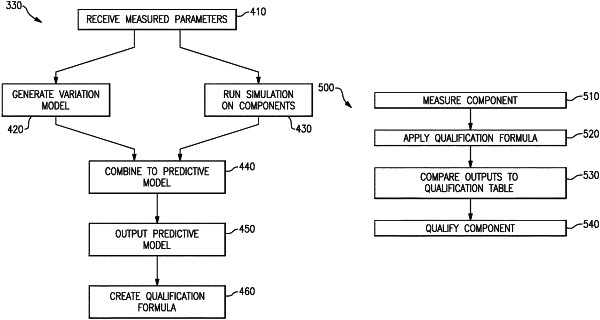| CPC G06F 30/20 (2020.01) [G06F 30/15 (2020.01); G06F 30/17 (2020.01); F05D 2260/81 (2013.01); G06N 20/00 (2019.01)] | 12 Claims |

|
1. A qualification system for gas turbine engine components comprising a computer system comprising:
a processor; and
a non-transitory memory storing instructions that, when executed by the processor, cause the processor to perform operations comprising:
receiving a set of measured parameters for each gas turbine engine component of a plurality of same gas turbine engine components, wherein the plurality of same gas turbine engine components consists of one of a first batch of components manufactured using a single manufacturing process OR a second batch of components manufactured using a uniform combination of processes and wherein the set of measured parameters comprises at least an airfoil geometric shape, stacking offset, chord profile, stagger angle, sweep angle, dihedral angle, and surface shape in an X, Y, Z coordinate system, and wherein at least a portion of the parameters are measured at multiple span positions;
generating, based on the set of measured parameters, a variation model configured to identify variations of each gas turbine engine component as compared to the plurality of same gas turbine engine components, wherein the variation model is a model of the variations on an average part manufactured using the one of the single manufacturing processes and the uniform combination of processes;
determining expected operational parameters of each gas turbine engine component based on a simulation of each gas turbine engine component of the plurality of same gas turbine engine components operating in a gas turbine environment;
generating a predictive model based on correlations between the expected operational parameters and the variations associated with respective gas turbine engine components, the predictive model configured to provide an output comprising an operational behavior associated with each gas turbine engine component operating in a gas turbine engine;
receiving measured, as-manufactured physical parameters of a new component, the new component being separate from, but a same type as, the plurality of same gas turbine engine components, wherein the new component is manufactured using a same manufacturing process as the plurality of same gas turbine engine components;
determining, based on the predictive model, whether the new component satisfies qualification criteria to be incorporated in the gas turbine engine; and
performing at least one of:
based on a determination that the new component satisfies the qualification criteria, determine that the new component is acceptable for incorporation in the gas turbine engine; or
based on a determination that the new component does not satisfy the qualification criteria, determine that the new component is not acceptable for incorporation in the gas turbine engine.
|